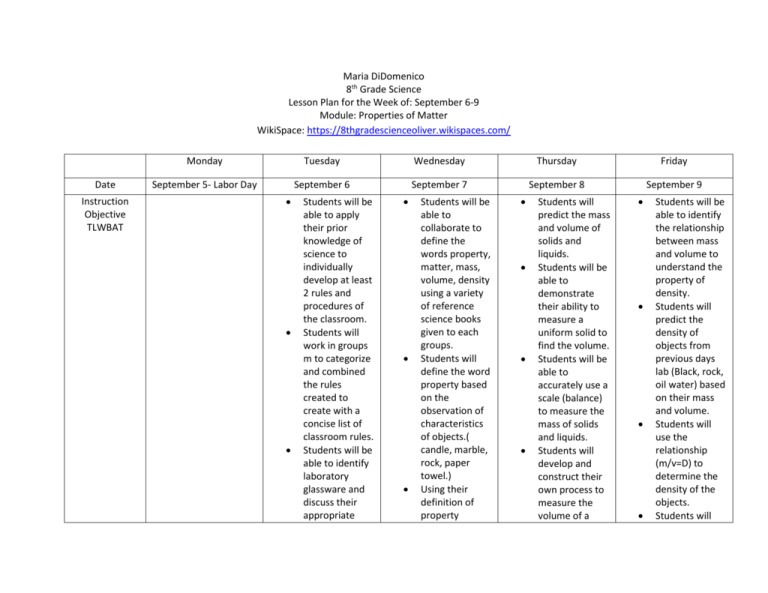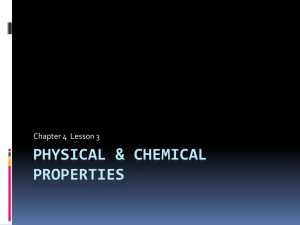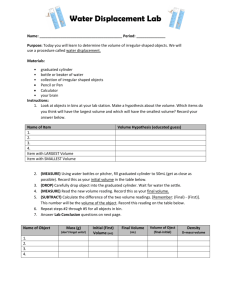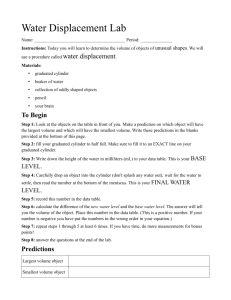Lesson Plan Sept 6-9 - 8thgradescienceoliver
advertisement

Maria DiDomenico 8th Grade Science Lesson Plan for the Week of: September 6-9 Module: Properties of Matter WikiSpace: https://8thgradescienceoliver.wikispaces.com/ Date Instruction Objective TLWBAT Monday Tuesday Wednesday Thursday Friday September 5- Labor Day September 6 September 7 September 8 September 9 Students will be able to apply their prior knowledge of science to individually develop at least 2 rules and procedures of the classroom. Students will work in groups m to categorize and combined the rules created to create with a concise list of classroom rules. Students will be able to identify laboratory glassware and discuss their appropriate Students will be able to collaborate to define the words property, matter, mass, volume, density using a variety of reference science books given to each groups. Students will define the word property based on the observation of characteristics of objects.( candle, marble, rock, paper towel.) Using their definition of property Students will predict the mass and volume of solids and liquids. Students will be able to demonstrate their ability to measure a uniform solid to find the volume. Students will be able to accurately use a scale (balance) to measure the mass of solids and liquids. Students will develop and construct their own process to measure the volume of a Students will be able to identify the relationship between mass and volume to understand the property of density. Students will predict the density of objects from previous days lab (Black, rock, oil water) based on their mass and volume. Students will use the relationship (m/v=D) to determine the density of the objects. Students will uses in the lab. NJCCS/CPIs 5.1.8.B.3 5.1.8.B.4 5.1.8.D.1 5.1.8.D.3 determine what the unit Properties of Matter will be on.(Defining Mass and Volume as characteristics of matter) 5.1.8.A.3 5.1.8.B.4 5.1.8.D.1 5.1.8.D.2 uniform solid (rock) using a gradated cylinder and water (Displacement). Students will use the graduated cylinder and read the meniscus to read the volume of a liquid accurately. Students will demonstrate their understand of accuracy and precision based on the correct usage of scientific equipment (beaker vrs graduated cylinder) 5.2.4.A.3 5.2.6.A.1 5.1.8.A.2 5.1.8.B.1 5.1.8.D.1 5.1.8.D.3 predict whether an object will float of sink based on the Density of water being 1 g/ml, and the density the have calculated for the objects. Students will test their predictions of sinking and floating. And modify their prior ideas based on the evidence and data. 5.2.6.A.2 5.2.6.A.3 5.1.8.A.1 5.1.8.A.2 5.1.8.D.1 5.1.8.D.3 Instructional Procedure Engagement: What are the reasons scientists need to follow procedures and rules? Quick Write (in notebook): Write 2 rules each we need to follow in this science class to be successful in learning. Engagement: The word “Stuff” will be written on the board. Quick write: This is what we will be studying, what does this mean? Engagement: You have 1 lb of feathers, a 1 lb of rocks, and 1 lb of sugar. Quick Write: Which would be greatest in volume and density? Each group will be provided with a small cup with a candle, marble, rock and paper towel. The students are Students will discuss asked to work together and compare the to observe and describe answers offered by each object as many students, and determine ways as possible. Then if there is a consensus of they must come up with opinion. Students will a definition for the word compare answers in property based on these their groups of 4-5 and characteristics each group will be asked (properties of each to provide 3-4 rules per object). group that will be included in classroom Each group will confer rules and procedures. with the reference books to define the Students will be given a words matter, mass and very short lab safety volume and will prepare Students will be working in groups of 4-5. To facilitate students in being responsible team members the following jobs were created. Students themselves decide who in the group will be: 1. Captain - This person is in charge of seeing to it that the group is organized, gets started on projects quickly and everyone knows what to do. 2. Monitor - This person keeps track of time to keep the group working smoothly. This Engagement: 1. Principle: If you pack more mass into a the same volume, it's more dense. Common experience: going on vacation, suitcase is too full to close Quick Write: Here are two other principles 2. Principle: If you pack the same mass into a smaller volume, it's more dense. 3. Principle: Just because something has more mass doesn't mean it's more dense. Come up with two common experiences that would fit the principle. Students will work in the same groups. They quiz. Students will be introduced to the class wikispage online. This space will allow for students to be in constant knowledge of what is to come. I will post lesson plans as well as several websites to visit. This will serve as a communication tool. The students will have weekly assignments in which they will have to post responses to questions I post online. Students will be introduced to journal/ notebook, glassware and materials that will be used throughout the Properties of Matter Unit. (Graduated cylinder, scale, Beaker, ) a small presentation for the class on large post-it paper. What “property of matter” means to and draw a diagram of the relationship between the words. person also sees to it that the group has everything it needs. The monitor is the only person who can pull the captain aside and remind her/him that s/he is not doing her/his job if the captain is off task. 3. Recorder - This person sees to it that the group has all the information it needs. This person sees to it that notes are taken or that information is copied from a website and saved. This person has the added responsibility to make sure that the team's work is original and not plagiarized. 4. Reporter - This person is in charge of reporting the group's accomplishments. When the group presents a final product, the reporter is in charge of seeing that it gets done on time and well. will switch positions in the group. Groups will be given the same materials as previous lab (odd shaped rock, Water, Veg. Oil, scale, beakers, graduated cylinder) as well as some anomaly objects such as a lava rock (porous) a bolt (very dense), and a moth ball (very dense, very small), aluminum foil ball (low denisty). They will be asked to determine which objects will sink or float of water based on the mass-volume relationship. Groups will be asked to develop their own method of testing their predictions. Each student will be responsible for completing lab sheet individually. Each group will be given a uniform solid (Block), a non-uniform solid (odd shaped rock), Water, Veg. Oil, scale, beakers, graduated cylinder. Their goals is to measure the mass and the volume of each object using prior math volume skills as well as using prior knowledge of displacement to measure volume. DifferentiationModifications Students will work both individually and collectively to make the rules of the classroom. Students will be provided with visual demonstration how to use as well as the names of the scientific tools. Each group will be provided with science reference books at varying reading levels. The class wiki (online), will have a interactive page that will allow for pictorial explanations of the words, property, matter, mass, and volume. The wikispace has several resources online that will help those groups who are struggling with the nonuniform solid to learn more about displacement and volume. Also the reference books have many explanations of this concept. Also real world explanation will be given to help explain displacement (sitting in a bath-tub). Each student will be responsible for completing lab sheet individually. The worksheet includes area for explanation of the concepts of density, mass, volume, sinking, floating (buoyancy) in many ways including mathematically, verbally, pictorially. Students will also be able to reference the wikispace and reference books for assistance in the lab. Assessment Diagnostics: Assess writing and collaborative skills. Determine the extent of background knowledge in science lab safety. Assessing eyesight issues for seat arrangement. Students will work in groups to prepare their definitions on a large post-it to present to the class. Exit Ticket: Students will write a statement on to create a concise definition to use for each word definitions from the group presentations. Students will individually complete 2 lab sheets, one for mass and the other for volume. Homework Daily: Any work that is not complete in class, must be completed for homework…all notebooks are to be in class every day or student is unprepared. Students must have lab safety sheet signed by parent/ guardian. Students will reflect on the classroom rules that were created to choose one rule that they believe needs to be enforced the most and what are the consequences of the class. They must write 35 sentences on why they choose that rule and the consequences. Now that you know the meanings of the words, property, matter, mass and volume? Reflect on your quick write answer and rewrite what Stuff is as it pertains to Properties of Matter unit. Way did I write Stuff on the board? Do you think air has a mass and volume? Explain in 3-5 sentences your reasoning. Students will complete a density lab worksheet. They will also be responsible for an online wikispace post based on the past two days lab on mass, volume, density. Wiki Post QuestionCritical Thinking: Explain why boats float on water in relationship to the vocabulary from the labs. During a storm, why do boats who take on water sink? Water has a Density of 1g/ml. Explain why oil floats on water in 3-5 sentences. Teacher Notes Listen and confer to establish the atmosphere and interest. Listen and walk around to each group to diagnose reading levels, group collaboration and Observation skills The groups will be heterogeneous and each student can use their strengths to work to complete the labs by allowing them to fill positions in the group. Listen and confer with groups to facilitate the lab.









